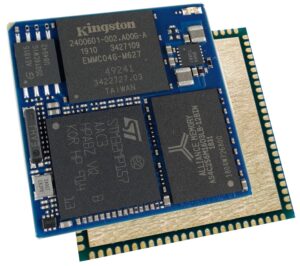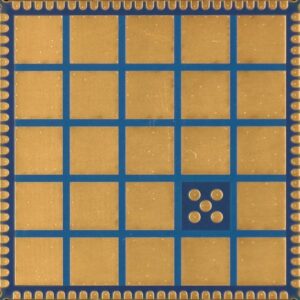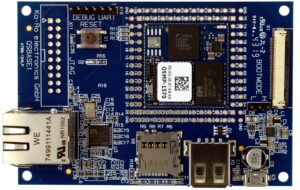Update, March 19, 2025
Following up on its long partnership with ST, Ka-Ro introduced new STM32 MPU SoM modules at Embedded World, which just took place. The QSMP-25 is their first module to include the STM32MP255. It comes with 1 GB of RAM and 4 GB of eMMC, and it features a socket made of two 80-pin connectors, which makes swapping modules a breeze. Ka-Ro also released the QSMP-13 for engineers looking to optimize their bill of materials by using an STM32MP135, 256 MB of RAM, and 4 GB of flash. Finally, the company made the QSMP-23 public. Close to the QSMP-25, it will also help teams bring costs down.
Original publication on May 18, 2020
In preparation for an ST Webinar on May 26, we wanted to look at Ka-Ro, a German SoM maker, a member of the ST Partner Program, and the creator of the QSMP-15 Series, which integrates the STM32MP15 in a QFN style package called a QSCOM. The QSMP-1530C includes an STM32MP157 with 256 MB of DDR3L, 4 GB of eMMC for storage, and a 24-bit RGB display interface with two additional MIPI-DSI lanes. The QSMP-1570 is very similar but includes 512 MB of RAM, while the QSMP-1570W comes with a Bluetooth and Wi-Fi module. And to make their SoMs accessible, Ka-Ro provides the QSMP-1570 in an evaluation board.
QSMP and STM32MP1: removing complexities and adding future-proofing

In the ten commandments of working with an MPU, we saw that system-on-module (SoM) makers could greatly help teams ship their final products faster by removing some of the complexities associated with microprocessor design. Teams, especially those coming from the microcontroller world, can easily fall prey to the we-can-do-it-ourselves virus, which causes the eternal-delaying-of-project-syndrome. When we sat down with Bob Blumenscheid, Ka-Ro’s Business Development in North America, and Michael Vyskocil, Manager of Product Development for the German company, they explained that,
“So many people come to us and tell us they had no idea designing a system with an MPU would take three, four, five, or even six years, but we do. We understand the expertise and know-how because of the long SoM experience we acquired before offering a product like the QSMP family of SoMs.”For instance, syncing and processing signals from the DDR3L is particularly complex, and teams have to come to terms with the fact that any upgrade to a newer MPU in a few years will require significant rework. Ka-Ro’s modules not only house packages but also technologies that ensure teams can vastly reduce their time to market because a QSMP SoM handles a lot of the complexities that bog down projects and delay releases. Additionally, because the QSCOM packages use a pinout structure that’s nearly identical from one model to the next, it’s possible to either swap QSMP models or to upgrade to a new one in a few years, with minimal changes, thus future-proofing a platform.
QSCOM, benefitting from a QFN package and unique ground pads

Another advantage specific to Ka-Ro’s SoMs is their new QSCOM module, and we were fascinated to learn that their STM32MP1 models were the first to use that package. One of its many advantages is its contact points on the side that make soldering and inspection a lot simpler since it doesn’t require an X-ray analysis. The QSCOM module also uses unique ground pads divided into large sections all across the bottom of the component. Such a structure ensures better signal integrity, increases the solder joint reliability, simplifies the self-alignment process, and improves the thermal dissipation. As Bob and Michael shared,
“Some of our customers had a hard time with other SMT SoMs because they were using a BGA or LGA packages that are harder to make while their smaller pitch limited the number of contract manufacturers that could install them.”Ka-Ro is an interesting member of the ST Partner Program because it’s not only a SoM maker but a surface mount production facility. The company thus used its expertise to design a QFN-like package that is far easier to assemble because it removes all the connectors traditionally present when using a SoM. This ease of use also translates into the ability to conceive a single-sided PCB with only two to four layers, depending on the design, thus decreasing production costs. It’d be nearly impossible for a team interested in an MPU to arrive at this optimization level if it started from scratch without investing so much time and resources as to make a single project unviable.
STM32MP1 and QSMP Evalkit, Exploiting All Features as Quickly as Possible

The QSMP Evalkit, while small, (60 mm x 90 mm), enables developers to enjoy all the features and power of the STM32MP1 before optimizing their system by only keeping relevant functionalities and determining the computational throughput necessary to run their applications. The QSMP Evalkit includes an Ethernet port, a USB port for power supply, an SD card slot for additional storage, a USB host, a TFT Display Connector, and solder pads for all of the 100 pins, thus fully opening up the SoM. Engineers can also solder a JTAG connector for additional convenience. Additionally, Ka-Ro can review custom design once engineers graduate from the evaluation board.
The QSMP Evalkit comes with Ka-Ro’s Linux distribution that their teams based on our OpenSTLinux Board Support Package (BSP) and which works in a headless setting. It means that the development board supports our development tools like STM32CubeMX. Moreover, developers can start writing their application on an STM32MP1 development board from ST and seamlessly move to a QSMP model with little to no code rewrite. The company also offers its SoM in a SO-DIMM form factor in case engineers would like to use more pins. Regardless of the model, all Ka-Ro SoMs are compatible with industrial applications, and their manufacturing capabilities received the ISO 9001:2015 certification.
